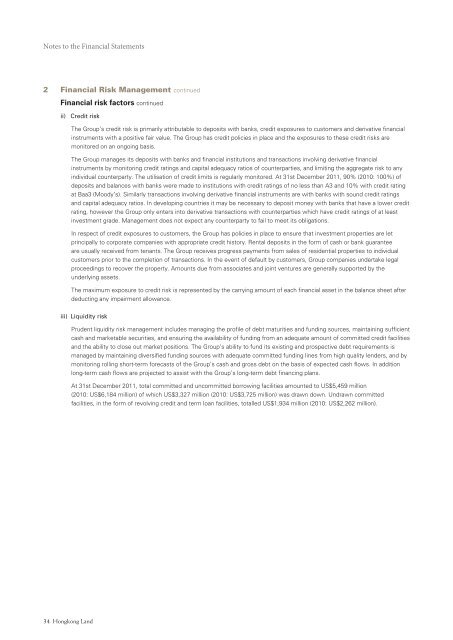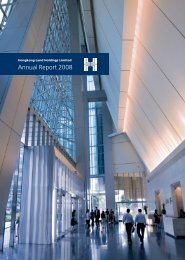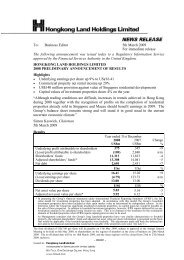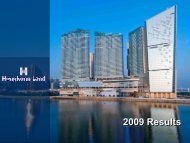Annual Report 2011 - Hongkong Land
Annual Report 2011 - Hongkong Land
Annual Report 2011 - Hongkong Land
Create successful ePaper yourself
Turn your PDF publications into a flip-book with our unique Google optimized e-Paper software.
Notes to the Financial Statements<br />
2 Financial Risk Management continued<br />
Financial risk factors continued<br />
ii) Credit risk<br />
The Group’s credit risk is primarily attributable to deposits with banks, credit exposures to customers and derivative financial<br />
instruments with a positive fair value. The Group has credit policies in place and the exposures to these credit risks are<br />
monitored on an ongoing basis.<br />
The Group manages its deposits with banks and financial institutions and transactions involving derivative financial<br />
instruments by monitoring credit ratings and capital adequacy ratios of counterparties, and limiting the aggregate risk to any<br />
individual counterparty. The utilisation of credit limits is regularly monitored. At 31st December <strong>2011</strong>, 90% (2010: 100%) of<br />
deposits and balances with banks were made to institutions with credit ratings of no less than A3 and 10% with credit rating<br />
at Baa3 (Moody’s). Similarly transactions involving derivative financial instruments are with banks with sound credit ratings<br />
and capital adequacy ratios. In developing countries it may be necessary to deposit money with banks that have a lower credit<br />
rating, however the Group only enters into derivative transactions with counterparties which have credit ratings of at least<br />
investment grade. Management does not expect any counterparty to fail to meet its obligations.<br />
In respect of credit exposures to customers, the Group has policies in place to ensure that investment properties are let<br />
principally to corporate companies with appropriate credit history. Rental deposits in the form of cash or bank guarantee<br />
are usually received from tenants. The Group receives progress payments from sales of residential properties to individual<br />
customers prior to the completion of transactions. In the event of default by customers, Group companies undertake legal<br />
proceedings to recover the property. Amounts due from associates and joint ventures are generally supported by the<br />
underlying assets.<br />
The maximum exposure to credit risk is represented by the carrying amount of each financial asset in the balance sheet after<br />
deducting any impairment allowance.<br />
iii) Liquidity risk<br />
Prudent liquidity risk management includes managing the profile of debt maturities and funding sources, maintaining sufficient<br />
cash and marketable securities, and ensuring the availability of funding from an adequate amount of committed credit facilities<br />
and the ability to close out market positions. The Group’s ability to fund its existing and prospective debt requirements is<br />
managed by maintaining diversified funding sources with adequate committed funding lines from high quality lenders, and by<br />
monitoring rolling short-term forecasts of the Group’s cash and gross debt on the basis of expected cash flows. In addition<br />
long-term cash flows are projected to assist with the Group’s long-term debt financing plans.<br />
At 31st December <strong>2011</strong>, total committed and uncommitted borrowing facilities amounted to US$5,459 million<br />
(2010: US$6,184 million) of which US$3,327 million (2010: US$3,725 million) was drawn down. Undrawn committed<br />
facilities, in the form of revolving credit and term loan facilities, totalled US$1,934 million (2010: US$2,262 million).<br />
34 <strong>Hongkong</strong> <strong>Land</strong>
















